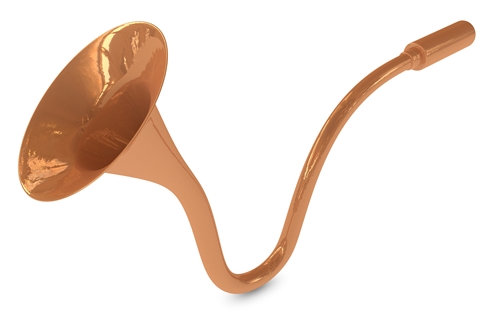
Communication is Your Key to A Good Connection
Have you ever wondered how a person with hearing aids follows a conversation in a noisy restaurant? Sounds come from all directions — dishes and cutlery clank in the background, other dining customers talk and laugh at nearby tables, while friends are sitting across the table talk about their experience from a recent vacation. Without hearing aids, a hearing-impaired person could not follow the conversation of their friends sitting at the same table.
The Evolution of Hearing Aids
In the eighteenth century, people used a large ear trumpet, which focused sounds and piped them straight into the ear canal. Today, we have an array of almost invisible digital hearing aids. Some are adaptable for very active users. Others are designed for music lovers or for those with a severe hearing loss. \

Figure 1 Ear trumpet was invented in the 18th century
Modern hearing aids found in the market today work like supercomputers, integrating sophisticated filtering technologies, such as noise reduction, reverberation suppression, feedback cancellation, and impulse reduction. The modern hearing aid enhances the speech of your conversation partner while filtering out the background noise, so you can clearly distinguish the conversation and enjoy a better listening experience.

Figure 2 Complete in canal (CIC) hearing aid
Putting the IoT in Hearing Aids
With the Internet of Things (IoT) taking center stage in everything we do today, hearing aids are designed to connect — using Bluetooth® Low Energy (BLE) connectivity. This common RF standard enables audiologists to configure and test their devices, while users can remotely control the device volume. The remote control capability is especially helpful given the small size of the actual earpiece. You can easily connect the hearing system to external multimedia devices. The sound is sent directly to the hearing aid, where you can control and fine-tune the volume and other settings using your smartphone. This integration draws much less attention than reaching up to adjust the volume of the hearing aid in your ear.
Thorough Test for the Real-World
Hearing aid manufacturers need to test and evaluate their products before shipping to customers to ensure they operate properly. With the integration of new technologies, hearing aid manufacturers require more complex test procedures to cover increasingly sophisticated connectivity, filtering, and speech enhancing functionality. American National Standards Institute (ANSI) and International Electrotechnical Commission (IEC) has laid out hearing aid-related standards to ensure there is a consistent method to measure and verify the performance of systems and devices. On top of that, special features like wireless Bluetooth® connectivity requires verification using appropriate test instruments.
Keysight has cost-effective, over-the-air (OTA) signaling test solutions that allow manufacturers to perform Bluetooth® Low Energy (BLE) signaling power measurements. This case study shows how a leading global manufacturer of hearing aids uses the Keysight X8711A IoT device functional test solution to reduce test time, save test costs, and perform accurate, quantitative tests.
Tiny in Size, Big on Impact
The advanced technologies embedded into modern hearing aids today make hearing loss a thing of the past. The connectivity, filtering, and speech enhancing functionality not only help individuals hear better, but they also improve their ability to communicate with their family and friends in a natural, effortless way. For more information on designing for the IoT and understanding the challenges you face, go to www.keysight.com/find/IoT and www.keysight.com/find/healthcareIoT.
Bluetooth® and the Bluetooth® logos are registered trademarks owned by Bluetooth SIG, Inc., and any use of such marks by Keysight Technologies is under license.\